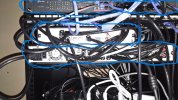We recently brought on a new client that has a existing Amcrest install by another company\person. They reached out to us due to all the issues they were having with the system (cams going down, and other odd things) and the current provider. We have been able to correct issues here and there but the install is a mess and seeking some more experienced insights and suggestions based on the current state of the setup.
What we know:
Amcrest is Dahua OEM
Total Cam count: 29
NVR #1: Amcrest NV5232E-16P (up to 32 Ch)
NVR #2: Amcrest NV4108-2TB (8 Ch)
Cams: Amcrest IP5M-T1179E (Majority) and 2-3 IP8M-2779E-AI
Switch: TP-Link TL-SL1226P
*Between the 5232 and the Switch, 25 are active. the remaining 4 are active on the 4108
*Camera cable runs are within 295'
*Found a couple Cameras utilizing external power injectors, but the 5232 power budget is well suited for the installed camera models
What we found is rather confusing and is not recommended by the manufacturer. There are two NVRs with only about half of their camera ports populated, the NVRs are uplinked via camera ports, and then some cameras are populated onto the Switch. There is no original installation documentation and the original installers couldn't provide any real dialog on to why or what issues they had leading to setting up the system this way.
Part of me wants to tear this down, default the NVR(s) and cams and redo it using the NV5232 and the switch as it it intended, for the current 29 cameras. But if I don't have to go that far, I prefer not to if possible. Would prefer to just migrate all 29 to the NV5232 and the Switch and clean things up from there.
What is your take on this setup? What would you do as a Integrator\Installer in this take-over situation? Interested in any setup suggestions as well.
What we know:
Amcrest is Dahua OEM
Total Cam count: 29
NVR #1: Amcrest NV5232E-16P (up to 32 Ch)
NVR #2: Amcrest NV4108-2TB (8 Ch)
Cams: Amcrest IP5M-T1179E (Majority) and 2-3 IP8M-2779E-AI
Switch: TP-Link TL-SL1226P
*Between the 5232 and the Switch, 25 are active. the remaining 4 are active on the 4108
*Camera cable runs are within 295'
*Found a couple Cameras utilizing external power injectors, but the 5232 power budget is well suited for the installed camera models
What we found is rather confusing and is not recommended by the manufacturer. There are two NVRs with only about half of their camera ports populated, the NVRs are uplinked via camera ports, and then some cameras are populated onto the Switch. There is no original installation documentation and the original installers couldn't provide any real dialog on to why or what issues they had leading to setting up the system this way.
Part of me wants to tear this down, default the NVR(s) and cams and redo it using the NV5232 and the switch as it it intended, for the current 29 cameras. But if I don't have to go that far, I prefer not to if possible. Would prefer to just migrate all 29 to the NV5232 and the Switch and clean things up from there.
What is your take on this setup? What would you do as a Integrator\Installer in this take-over situation? Interested in any setup suggestions as well.

